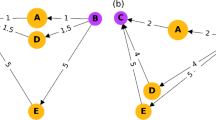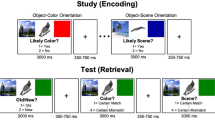Abstract
Individuals with autism spectrum disorders (ASD) demonstrate impaired utilization of context, which allows for superior performance on the “false memory” task. We report the application of a simplified parallel distributed processing model of context utilization to the false memory task. For individuals without ASD, experiments support a model wherein presentation of one word, e.g., ‘‘apple,’’ strongly activates the neighboring nodes of closely related words such as ‘‘fruit,’’ ‘‘tree,’’ whereas in ASD these neighboring nodes are relatively less activated. We demonstrate this model to be consistent with the superior performance on recognition testing on the false memory test, but not on free recall. This may have an anatomic basis in diminished hippocampal neuronal arborization and the abnormal minicolumnar pathology in ASD.



Similar content being viewed by others
References
Bailey, A., Luthert, P., Dean, A., Harding, B., Janota, I., Montgomery, M., Rutter, M., & Lantos, P. (1998). A clinicopathological study of autism. Brain, 121, 889–905.
Bauman, M., & Kemper, T. L. (1986). Developmental cerebellar abnormalities: A consistent finding in early infantile autism. Neurology, 35, 866–874.
Bauman, M., & Kemper, T. L. (1994). Neuroanatomic observations of the brain in autism. In M. Bauman, & T. L. Kemper (Eds.), The neurobiology of autism (pp. 119–145). Baltimore, MD: The Johns Hopkins University Press.
Beversdorf, D. Q., Smith, B. W., Crucian, G. P., Anderson, J. M., Keillor, J. M., Barrett, A. M., Hughes, J. D., Felopulos, G. J., Bauman, M. L., Nadeau, S. E., & Heilman, K. M. (2000). Increased discrimination of ‘false memories’ in autism spectrum disorder. Proceedings of the National Academy of Sciences in the United States of America, 97, 8734–8737.
Bowler, D. M., Gardiner, J. M., Grice, S., & Saavalainen, P. (2000). Memory illusions: False recall and recognition in adults with Asperger’s Syndrome. Journal of Abnormal Psychology, 109, 663–672.
Casanova, M. F., Buxhoeveden, D. P., Switala, A. E., & Roy, E. (2002). Minicolumnar pathology in autism. Neurology, 58, 428–432.
Cohen, I. L. (1994). An artificial neural network analogue of learning in autism. Biological Psychiatry, 36, 5–20.
Frith, U., & Happé, F. (1994). Autism: Beyond “theory of mind.” Cognition, 50, 115–132.
Gabrieli, J. D. E., Cohen, N. J., & Corkin, S. (1988). The impaired learning of semantic knowledge following bilateral medial temporal lobe resection. Brain and Cognition, 7, 157–177.
Goldstein, G., Minshew, N., & Siegel, D. (1994). Age differences in academic achievement in high-functional autistic individuals. Journal of Clinical and Experimental Neuropsychology, 16, 671–680.
Happé, F. G. E. (1996). Studying weak central coherence at low levels: Children with autism do not succumb to visual illusions. A Research Note. Journal of Child Psychology and Psychiatry, 37, 873–877.
Happé, F. G. E. (1997). Central coherence and theory of mind in autism: Reading homographs in context. British Journal of Developmental Psychology, 15, 1–12.
Hermelin, B., & O’Connor, N. (1967). Remembering words by psychotic and subnormal children. British Journal of Psychology, 58, 213–218.
Just, M. A., Cherkassky, V. L., Keller, T. A., & Minshew, N. J. (2004). Cortical activation and synchronization during sentence comprehension in high-functioning autism: Evidence of underconnectivity. Brain, 127, 1811–1821.
Kemper, T. L., & Bauman, M. (1993). The contribution of neuropathologic studies to the understanding of autism. Neurologic Clinics, 11, 175–187.
McClelland, J. L. (2000). The basis of hyperspecificity in autism: A preliminary suggestion based on properties of neural nets. Journal of Autism and Developmental Disorders, 30, 497–502.
Mottron, L., Peretz, I., & Ménard, E. (2001). Local and global processing of music in high-functioning persons with autism: Beyond central coherence? Journal of Child Psychology and Psychiatry, 41, 1057–1065.
O’Connor, N., & Hermelin, B. (1967). Auditory and visual memory in autistic and normal children. Journal of Mental Deficiency Research, 11, 126–131.
Roediger, H. L., & McDermott, K. B. (1995). Creating false memories: Remembering words not presented in lists. Journal of Experimental Psychology: Learning, Memory and Cognition, 21, 803–814.
Rumelhart, D. E., & McClelland, J. L. (1986). Parallel distributed processing: Explorations in the microstructure of cognition (Vols. 1 and 2). Cambridge, MA: MIT Press.
Russell, J. (1997). Introduction. In: J. Russell (Ed.), Autism as an executive disorder (pp. 1–20). New York: Oxford University Press.
Shah, A., & Frith, U. (1983). An islet of ability in autistic children: A research note. Journal of Child Psychology and Psychiatry, 24, 613–620.
Shah, A., & Frith, U. (1993). Why do autistic individuals show superior performance on the block design task? Journal of Child Psychology and Psychiatry, 34, 1351–1364.
Acknowledgements
This research was funded by the Stallone Fund, and in part by a Grant from NINDS (K23 NS43222-Beversdorf). Portions of this research were presented at the 6th Autism Europe Congress, 2000, and the International Meeting for Autism Research, 2002.
Author information
Authors and Affiliations
Corresponding author
Rights and permissions
About this article
Cite this article
Beversdorf, D.Q., Narayanan, A., Hillier, A. et al. Network Model of Decreased Context Utilization in Autism Spectrum Disorder. J Autism Dev Disord 37, 1040–1048 (2007). https://doi.org/10.1007/s10803-006-0242-7
Published:
Issue Date:
DOI: https://doi.org/10.1007/s10803-006-0242-7




